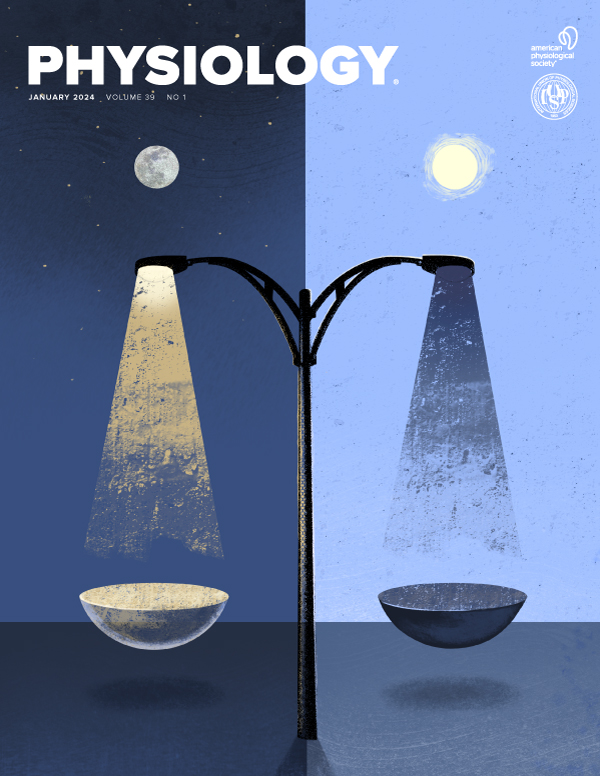年龄和握力导致微血管和大血管反应的差异
IF 5.3
2区 医学
Q1 PHYSIOLOGY
引用次数: 0
摘要
目的:手握力(HG)是心血管疾病(CVD)和全因死亡率的有力预测指标。技术的进步为外周微血管和大血管的健康和功能提供了新的评估方法。这些进步包括在血管闭塞试验(VOT)中使用近红外光谱(NIRS)测量骨骼肌组织氧合(StO2,%)以及颈动脉-股动脉脉搏波速度(cfPWV),后者是目前测量主动脉僵硬度的黄金标准。虽然 NIRS-VOT 和 cfPWV 已被证明会在整个生命周期中发生变化,但这些变量是否对 HG 强度所定义的群体差异敏感还不得而知。因此,我们的目的是研究 HG 强度低和高组间 NIRS-VOT 参数和 cfPWV 的平均差异。我们假设 HG 强度较低的个体会表现出较低的血管功能。方法:将 67 名成年人分为不同年龄组:青年组(19 - 40 岁)、中年组(41 - 64 岁)和老年组(≥ 65 岁)。以 HG 强度的中位数分为低强度组和高强度组,并根据生理性别进行准平衡。这样就产生了六个参与者组(例如,中年低强度组)。VOT 包括 3 分钟休息、5 分钟缺血和 3 分钟再灌注,以确定反应性充血指数。指标包括初始(即前 10 秒)再饱和率(upslope)和缺血后最大 StO2(StO2max)百分比。使用颈动脉和股动脉搏动出现的时间差将主动脉僵硬度定义为 cfPWV。对每种结果分别进行了 2×3 因子间方差分析(按年龄组划分的 HG)。P≤0.05为差异显著,数据以均数±标准差表示。结果对于上坡,存在显著的交互作用(p=0.042,ηp2=0.078),后续分析表明,对于年轻人和中年人,高 HG 组比低强度组表现出更大的上坡(年轻人:2.24±0.9 vs. 1.64±0.7,中年人:2.21±0.9 vs. 1.59±0.7%∙s-1)。StO2max 没有明显的交互作用(p=0.360),但有明显的主效应(p 80.7 ± 2.3 > 77.3 ± 2.8%)。同样,cfPWV 也显示出年龄的显著主效应(p<0.001;ηp2 =0.429),表明主动脉僵化会随着年龄的增长而恶化,与 HG 强度无关。结论这些结果表明,上坡对 HG 强度的组别差异很敏感,但仅适用于青年和中年组。对于 StO2max 和 cfPWV,年龄差异似乎比 HG 强度的影响更大。目前的研究结果表明,HG 强度可能最能反映血管树的特定部分,而初始再饱和率和 StO2max 可能受到与反应性充血相关的不同机制的影响。值得注意的是,本研究的参与者都相对健康,没有任何慢性疾病。有必要在未来开展工作,确定 NIRS-VOT 参数对未来心血管疾病发病的预测能力。我们要感谢美国生理学会的支持以及南阿拉巴马大学允许我们使用其设施。我们还要感谢所有同意遵守本研究协议和程序的参与者。本文是在 2024 年美国生理学峰会上发表的摘要全文,只有 HTML 格式。本摘要没有附加版本或附加内容。生理学》未参与同行评审过程。本文章由计算机程序翻译,如有差异,请以英文原文为准。
Age and Handgrip Strength Induce Differences in Micro- and Macro-Vascular Responses
Purpose: Handgrip (HG) strength is a potent predictor of cardiovascular disease (CVD) and all-cause mortality. Advances in technology have provided novel assessments of peripheral microvascular and macrovascular health and function. These advances include measurements of skeletal muscle tissue oxygenation (StO2, %) with near-infrared spectroscopy (NIRS) during vascular occlusion tests (VOT) as well as carotid-femoral pulse-wave velocity (cfPWV), which is the current gold-standard to measure aortic stiffness. Although NIRS-VOT and cfPWV have been shown to change across the lifespan, it is unknown if these variables are sensitive to group differences as defined by HG strength. Therefore, our purpose was to examine mean differences in NIRS-VOT parameters and cfPWV between groups of low and high HG strength. We hypothesized that individuals with lower HG strength would exhibit lower vascular function. Methods: 67 adults were separated into age groups: young (19 – 40 yr), midlife (41 – 64 yr), and older (≥65 yr). Groups were divided into low and high strength at the median for HG strength, and quasi-balanced based on biological sex. This resulted in six participant groups (e.g., midlife low strength). The VOT included 3 min of rest, 5 min of ischemia, and 3 min of reperfusion to determine indices of reactive hyperemia. Indices included the initial (i.e., first 10 s) rate of re-saturation (upslope) and the maximal StO2 (StO2max) percent following ischemia. Aortic stiffness was defined as cfPWV using the time difference between the appearance of the carotid and femoral pulses. Separate 2×3 between factor (HG by Age Group) ANOVAs were conducted for each outcome. A p≤0.05 was considered significant, and data were presented as mean ± SD. Results: For upslope, there was a significant interaction (p=0.042, ηp2=0.078), and follow-up analyses revealed for young and midlife adults the high HG group exhibited greater upslopes than the low strength group (young: 2.24±0.9 vs. 1.64±0.7 and midlife: 2.21±0.9 vs. 1.59±0.7%∙s−1). There was no significant interaction (p=0.360) for StO2max, but there was a significant main effect (p<0.001) of Age such that it progressively decreased across the lifespan (83.9 ± 2.0 > 80.7 ± 2.3 > 77.3 ± 2.8%). Similarly, cfPWV exhibited a significant main effect (p<0.001; ηp2 =0.429) of Age indicating aortic stiffness worsened with age, independent of HG strength. Conclusions: These results indicated that upslope was sensitive to group differences in HG strength, but only in the young and midlife age groups. For StO2max and cfPWV, age differences appeared to elicit a stronger effect than HG strength. The current findings suggested that HG strength may be most reflective of a specific portion of the vascular tree, while the initial rate of re-saturation and StO2max may be influenced by different mechanisms associated with reactive hyperemia. Notably, the participants in this study were relatively healthy based on being free of any chronic disease. Future work is necessary to determine the predictive power of NIRS-VOT parameters for future onset of CVD. We would like to thank the American Physiology Society for support and the University of South Alabama for allowing us to use its facilities. We would also like to thank all of the participants who agreed to adhere to the protocol and procedures of this study. This is the full abstract presented at the American Physiology Summit 2024 meeting and is only available in HTML format. There are no additional versions or additional content available for this abstract. Physiology was not involved in the peer review process.
求助全文
通过发布文献求助,成功后即可免费获取论文全文。
去求助
来源期刊

Physiology
医学-生理学
CiteScore
14.50
自引率
0.00%
发文量
37
期刊介绍:
Physiology journal features meticulously crafted review articles penned by esteemed leaders in their respective fields. These articles undergo rigorous peer review and showcase the forefront of cutting-edge advances across various domains of physiology. Our Editorial Board, comprised of distinguished leaders in the broad spectrum of physiology, convenes annually to deliberate and recommend pioneering topics for review articles, as well as select the most suitable scientists to author these articles. Join us in exploring the forefront of physiological research and innovation.
 求助内容:
求助内容: 应助结果提醒方式:
应助结果提醒方式:


